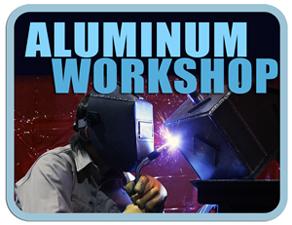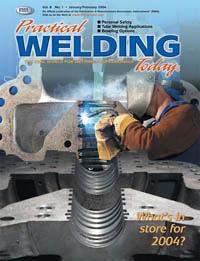President
- FMA
- The Fabricator
- FABTECH
- Canadian Metalworking
Categories
- Additive Manufacturing
- Aluminum Welding
- Arc Welding
- Assembly and Joining
- Automation and Robotics
- Bending and Forming
- Consumables
- Cutting and Weld Prep
- Electric Vehicles
- En Español
- Finishing
- Hydroforming
- Laser Cutting
- Laser Welding
- Machining
- Manufacturing Software
- Materials Handling
- Metals/Materials
- Oxyfuel Cutting
- Plasma Cutting
- Power Tools
- Punching and Other Holemaking
- Roll Forming
- Safety
- Sawing
- Shearing
- Shop Management
- Testing and Measuring
- Tube and Pipe Fabrication
- Tube and Pipe Production
- Waterjet Cutting
Industry Directory
Webcasts
Podcasts
FAB 40
Advertise
Subscribe
Account Login
Search
Aluminum Workshop: What is cast and helix?
- By Frank Armao
- Updated August 8, 2023
- January 5, 2015
- Article
- Aluminum Welding
Q: What are cast and helix? I keep hearing about them, but no one seems to really know what they are.
A: First of all, cast and helix are two separate attributes of spooled wires intended for gas metal arc welding (GMAW). The terms have no meaning for straight cut lengths of wire meant for gas tungsten arc welding (GTAW).
The cast of the wire is just the diameter of the loop the wire forms when it comes off the spool. It’s pretty obvious that if you wrap wire on a spool, like the 16- or 20-pound spools usually used for aluminum GMAW wire, it won’t be straight when it come off the spool. Instead, it’s curved. You might think that this will be the diameter of the spool, but in most cases, it’s not.
Measuring Cast
The easiest way to measure cast is to unwrap two or three turns of wire from a spool, trying not to deform the wire as you are unwinding it. Let the wire lie freely on the floor, and measure the diameter of the loops that it forms. This is the cast.
Wire manufacturers measure cast in a slightly different way: They slide the loops of wire over a horizontal rod and measure the diameter of the loops. However, the first method is easier and accurate enough for our purposes.
In the method of measuring cast that involves sliding over a horizontal rod, helix is the distance along the rod between one wrap and the next. If you lay the wires on the floor, helix is the height of the end of the wire off the floor. Again, this method is easy and accurate enough in almost any application.
Now that you know what cast and helix are, are they good or bad for you? How much of either should you expect to see on a spool of aluminum filler wire?
Are Cast and Helix Good or Bad?
Well, one statement that no one can argue is that helix is bad for you. Aluminum welding wires are made to the American Welding Society (AWS) A5.10 specification, which limits the helix to no more than 1 inch. Most wire manufacturers aim for much less than that.
If your wire comes off the spool in a big corkscrew, you have an example of extremely large helix. Don’t use it. At best, the tip of the wire will wander all over as it comes out of the GMAW gun. At worst, it will cause feeding difficulties. In semiautomatic welding, this makes your job difficult because you’ll be moving the torch constantly to compensate for the wire movement. In robotic or automatic welding, such wire movement can cause the weld to miss the weld seam.
By the way, fi the wire comes off the spool with little or no helix but it comes out of the torch in a corkscrew, that’s not the wire’s fault. You have a misaligned drive roll in the feeder or something else in the feeding system that’s putting a sideways force on the wire.
The situation with regard to cast isn’t as simple. The wire cast is controlled by the wire manufacturer in the details of the wire spooling. It’s not merely equal to the diameter of the spool it is wound on.
Some cast is desirable. Remember, you need good contact between the wire and the contact tip to transfer current so you can melt the wire. The wire cast makes the wire behave like a spring, keeping the wire in contact with the contact tip on its way through.
A common mistake is to put a wire straightener on the wire feede3r and remove all the cast from the wire. Some users combine this practice with the use of oversize contact tips and then wonder why they get a lot of burnbacks. Simple, isn’t it? The wire isn’t making good contact in the contact tip.
Too much cast is bad too. It can make pulling the wire off the spool difficult. It also can cause wire-shaving problems if the sharply curved wire scrapes against a burr somewhere in the wire feeding system. These wire shavings can plug up a liner quickly. If you see fine wire shavings anywhere in the system, or if you see tiny balls that look like steel wool, you are shaving wire. The wire can cause wire shaving, but more often it’s cause by incorrect feeder or torch setup.
If too much cast is bad and too little cast is bad, how much cast should the wire have? North American wire manufacturers typically aim for cast in the range of 10 to 20 in. European wire manufacturers typically aim for cast in the range of 20 to 30 in. Wires anywhere in this range typically work well. AWS A5.10 doesn’t dictate a requirement for cast. It only says that the wire should have a cast that allows it to feed well.
All of this is true for aluminum of standard spools of 16 lbs. or larger. The situation is different when aluminum wire is spooled on 1-lb. spools. In this case, the spool diameter is small enough that the manufacturer can’t control the cast as well.
Typically, the wire is plastically deformed in spooling, so the cast is a little bit larger than the spool diameter. Because 1-lb. spools almost always are fed through spool guns, this still gives acceptable feedability because the wire is being fed only a short distance. However, the last few turns of wire on the spool often won’t feed well, especially if it’s a stiff wire like 3/64-in. 5356. In any case, the helix should still be less than 1 in., even on these small spools.
About the Author

Frank Armao
Aluminum Consulting Inc.
440-479-0239
About the Publication
Related Companies
subscribe now

The Welder, formerly known as Practical Welding Today, is a showcase of the real people who make the products we use and work with every day. This magazine has served the welding community in North America well for more than 20 years.
start your free subscription- Stay connected from anywhere

Easily access valuable industry resources now with full access to the digital edition of The Fabricator.

Easily access valuable industry resources now with full access to the digital edition of The Welder.

Easily access valuable industry resources now with full access to the digital edition of The Tube and Pipe Journal.
- Podcasting
- Podcast:
- The Fabricator Podcast
- Published:
- 04/16/2024
- Running Time:
- 63:29
In this episode of The Fabricator Podcast, Caleb Chamberlain, co-founder and CEO of OSH Cut, discusses his company’s...
- Industry Events
16th Annual Safety Conference
- April 30 - May 1, 2024
- Elgin,
Pipe and Tube Conference
- May 21 - 22, 2024
- Omaha, NE
World-Class Roll Forming Workshop
- June 5 - 6, 2024
- Louisville, KY
Advanced Laser Application Workshop
- June 25 - 27, 2024
- Novi, MI
































